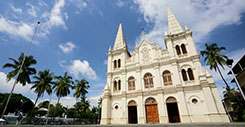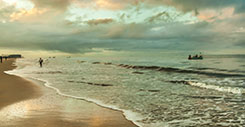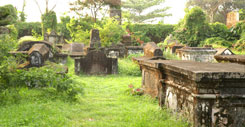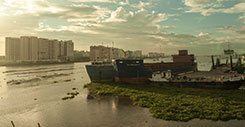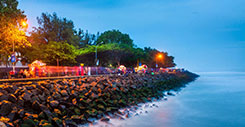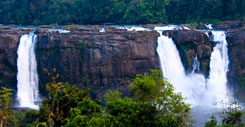Vypin Island was formed after the great floods of AD 1341. The Island is 25 Kilometer long and has an average width of 2 kilometers. Pallipuram Panchayat, in which Cherai is included, is at the northern end of Vypin Island. Cherai and Munambam are the two parts of Pallipuram Village, which were parts of Kochi and Travancore States prior to the merger of the states. Vypeen is mostly densely populated and has earned a place in the Guinness Book of World Records as the "thickly populated Island" in the world The light-house at Ochanthuruth is a vantage point to enjoy a panoramic view of Kochi. The entry time to light-house is 3.00 to 5.00 pm. Extreme north lies Pallipuram Fort built by Portuguese in 1503.
Santa Cruz Basilica
The Portuguese built Santa Cruz Cathedral Basilica's 500th anniversary was very recently. With gracious interiors, Gothic fade with soaring and glaring spires, the Basilica is charming. The Dutch catch of Koch in 1663 resulted in booming of warehouses in places of worships. The irresistible beauty might have persuaded the Dutch to spare it. The stained-glass and the life-like caryatids watching over the quaint confessional boxes will be ever-green in the mind once seen.
St Fransis Church
Built in timber by Portuguese in 1503, it was overlaid with stone masonry later. Vasco da Gama was cremated here in 1524. His remains were later removed to Lisbon. His tomb still exists. Now taken care by Church of South India. The gravestones were tossed into the walls of the church in 1886. The 'Doop Book', that is, old baptism and the marriage register, from 1751 to 1804 kept in the vestry are the delights of history-seekers.
Dutch Cemetery
Parallel to the beach, the Dutch Cemetery is the peace-home of soldiers and trade adventurists who died between 17th and 18th century. Now it is getting renovated (the real face is changing)
Princess street
Flowerpot laden window sills, bronze stucco walls and peeling pastel - these all are the symbols of colonial style buildings. See them in Princess street - a back street now filled with antique shops, homestays and hotels, without disturbing the originality. Fort Kochi really revels in moody pastimes.
Water Front
A little walkway is Vasco da Gama Square, a narrow promenade running along the beach. Huge cantilevered Chinese Fishing Nets, just before the beach, call the visitors. The system works this way - a bamboo-and-teak contraption with net-spread hanging get pulled down to the water and hauled with the catch. This catching process is usually in the morning and early evening. Watch sunset from the edge of the pathways.
The Fort Kochi beach is clean and small.But not for sunbath. At one-end there is a pretty old light-house. Recline on the white sands with the local crowd when the eyes will sharp on Lakhadweep-bound ships. Ferry to little away sporadic Cherai beach. The receptive white sand there will force to recline, sleep, dance or to football. And swim and sniff. If lucky, dolphins will greet you.
Mattancherry
Mattancherry Palace with its medieval charm is situated at Palace Road, Mattancherry, Kochi. It was built by the Portuguese and presented to Veera Kerala Varma (1537-65), Raja of Kochi, in 1555 AD. The Dutch carried out some extensions and renovations in the palace in 1663, and thereafter it was popularly called Dutch Palace. The Rajas also made more improvements to it. Today, it is a portrait gallery of the Cochin Rajas and notable for some of the best mythological murals in India, which are in the best traditions of Hindu temple art. The palace was built to appease the king after they plundered a temple nearby.
St. Francis Church
St. Francis CSI Church, in Kochi, earlier called Cochin, originally built in 1503, is the oldest European church in India and has great historical significance as a mute witness to the European colonial struggle in the subcontinent. The Portuguese explorer, Vasco da Gama, died in Kochi in 1524 when he was on his third visit to India. His body was originally buried in this church, but after fourteen years his remains were removed to Lisbon.
Cherai Beach
Cherai Beach is located in Vypin island, Kochi, India. Cherai Beach is just 25 km from Kochi, the business capital of Kerala and 30 km from Cochin International Airport. The nearest towns are North Paravur (6 km) and Kodungallur (10 km) and the nearest railway station is Aluva (20 km).
The 15 km of long golden beach is clean, shallow, and attracts swimming and sunbathing. It is one of the few places where one can experience the lagoon (poyil) and ocean separated only by a few hundred meters. One of the main events in Cherai Beach is the tourism fest during December. Best season to visit is all throughout the year barring the rainy season (June - October). Tourists can find beach resorts and cottages close to the beach.
Athirappilly
Athirappilly is a first grade Grama Panchayath with 489.00 Sq. km. area in Mukundapuram Taluk, Thrissur district in Kerala, India. It is located 60 km from Thrissur city , 70 km from Kochi city, 50 km from Cochin International Airport, and 30 km from Chalakudy town.
Wildlife
The Athirappilly Falls are situated on the Chalakudy river, which originates in the upper reaches of the Western Ghats. Many endangered and endemic species of flora and fauna are found in the forests of the Athirapilly-Vazhachal area. This area is the only place in the Western Ghats where four endangered Hornbill species are seen. The Western Ghats is one of the most important biodiversity hot spot in the world.
